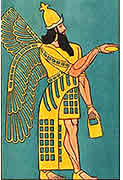| |||||||||||||||||||||||||||||||||
| Facts > Pagan Christs > Attis | |||||
| Glycon | Simon | Apollonius of Tyana | Pythagoras | Orpheus | |
| Isis / Osiris | Dionysus | Zalmoxis | Kore | Samothrace | |
| Heroes | Attis | Adonis | Mithras | Other godmen |
| Attis 500 BC - a dying, resurrected savior |
|
Phrygia (aka Anatolia = modern Turkey) Birth Attis was born of the Virgin Nana on December 25th. He was both the Father and the Divine Son. |
|
They were baptized in this way: a bull was placed over a grating, the devotee stood under the grating. The bull was stabbed with a consecrated spear. "It's hot reeking blood poured in torrents through the apertures and was received with devout eagerness by the worshiper...who had been born again to eternal life and had washed away his sins in the blood of the bull." [for more see Frazer, Attis, chapter 1]
[
|
|
The Festival of Joy—the celebration of Attis' death and rebirth On March 22 a pine tree was brought to the sanctuary of Cybele, on it hung the effigy of Attis. The God was dead.Two days of mourning followed. On the eve of the third day, March 25th, the worshippers turned to joy. |
|




